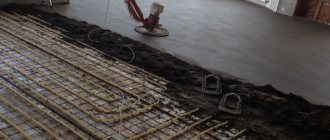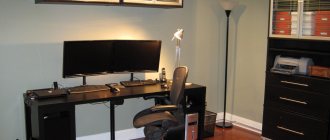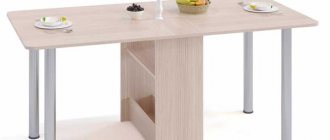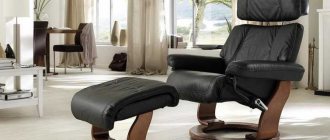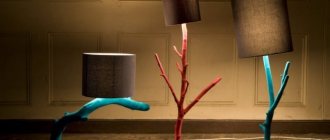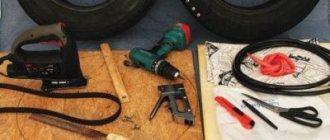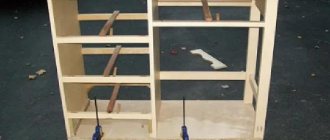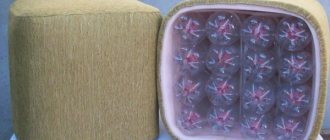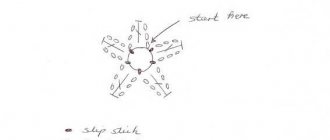Pros and cons of dry floor screed
The price for installation of this type of coating ranges from 200-500 rubles per square meter. However, installing a dry floor screed with your own hands does not require any special skills or special tools, and takes a couple of days in a small house, after which the coating can be used immediately. This allows you to get a flat floor for less money without pouring a concrete screed.
This screed is perfect for:
- level the floor with large differences in height;
- install the screed in the cold season in a room without heating;
- strengthen the old floor;
- close the wiring and heating pipes running along the floor;
- quickly install the floor.
Pros of dry screed
Like any other coating, such a screed has its pros and cons. The advantages include the following points:
- Easy to install covering. Due to the fact that installation does not require special expensive tools and materials, installation of a dry screed can be done with your own hands without much effort.
- Quick installation. The technology involves the use of ready-made floor elements with a fairly large area, so this method of forming a screed takes 2-3 days for houses with an area of up to 100 square meters.
- Cost of materials. The main cost item when using screed floor technology is gypsum fiber floor elements. However, in any case, dry screed is cheaper than concrete screed or semi-dry floor screed.
- High strength. Despite its apparent non-monolithic nature, dry screed has sufficient strength characteristics. Experiments have proven that such a coating can withstand the weight of a car.
- Good thermal insulation and protection against impact noise. Thanks to the use of fine expanded clay, which has a porous structure, as backfill, the bulk screed has fairly high sound-proofing qualities. The absence of direct contact between gypsum fiber board floor slabs and floor slabs allows the floor to always remain warm.
- Perfectly flat surface. One of the main advantages of dry floor screed is the production of a perfectly flat surface with minimal differences without bumps and depressions, which does not require pouring a self-leveling floor. On such a surface you can immediately lay laminate, parquet, or other finishing coating.
- Minimum weight of the finished screed. This advantage plays a big role when installing in houses with wooden floors, when you want to get a smooth, non-creaky surface.
- Possibility of laying electrical wiring, as well as water supply and sewerage pipes into the screed.
- Lack of dirt and dust during installation, unlike other types of rough floor screeds.
Cons of dry screed
This type of rough coating does not have any serious disadvantages. However, those that are available often play a significant role in the choice.
- Fear of moisture. Under no circumstances should such floors be exposed to wetness or water spillage. If a dry screed spills, you will have to open the coating and dry the bulk material, and then reinstall it. Otherwise, stagnant moisture will lead to the formation of fungus.
- Dry screed is quite demanding in terms of installation technology. If errors were made during installation, then in the future, due to uneven loads on the floor surface, voids may form under it. Voids lead to sagging of the flooring, which leads to a loss of the “hard floor” feeling.
- According to manufacturers, the service life of dry screed components is at least 10 years, which is much less than traditional rough coatings.
The disadvantages of dry screed most often appear due to installation errors. Studying the technology and installing dry floor screed with your own hands will help you avoid the mistakes of unscrupulous craftsmen.
About the advantages and disadvantages
Comparing the equipment technology for dry and wet screeds, we can highlight a number of positive aspects for the first option:
- a significant advantage is the deadlines. In a medium-sized room, you can level the floor in a day or two;
- The dry installation method does not create a large amount of dirt and relative order can be maintained in the apartment. In addition, the absence of dust from cement ensures the normal condition of people suffering from lung disease or asthma;
- reduced labor intensity of work, especially for unloading and delivering materials to the work site;
- no need to use construction equipment such as concrete mixers or mixers;
- the use of dry screed allows for hidden placement of communications;
- additional heat and sound insulation of floors;
- comparative ease of overlapping, due to the characteristics of the materials used.
It is the latter circumstance that in some cases is the decisive factor for choosing a floor leveling option. At the same time, such a floor is strong enough to perform its main functions.
The properties of dry screed allow it to be used over an old wooden floor. Naturally, before performing it, you need to carefully examine its condition, replace damaged areas and putty the damage and cracks.
There are practically no restrictions on the use of finishing coating on dry screed, and repairs can be continued without stopping.
At the same time, there are also disadvantages of this solution, these include the following points:
- dry screed is not used in rooms where it is necessary to make slopes for water drainage, usually these are bathrooms and bathrooms;
- restrictions on the use of underfloor heating technologies; there is no point in arranging water or electric options. Only infrared film floors can serve as a suitable solution;
- Brick or tongue-and-groove slabs cannot be used for interior partitions over this type of coating. A suitable solution can only be the construction of partitions from OSB or plasterboard materials.
See also: How to lay tiles
Why dry
Traditional types of cement screeds have been successfully used in practice for many decades. The classic components for such screeds were necessarily:
Only their ratio and the quality of individual components changed. But specialists from the German company Knauf took up the implementation of a new project suitable for leveling the floor - it was they who came up with the joint use of materials such as dry screed and gypsum fiber sheets (gypsum fiber sheets). The technology turned out to be so simple that it became accessible to everyone. Here, in addition to GVL, expanded clay sand will be required as the basis of the screed.
First, bulk material is poured onto the subfloor - expanded clay, which is sprinkled with sand or perlite, and then tile materials are laid on top: gypsum fiber board, fiberboard, chipboard or plywood. The modules of the upper fastening layer are fastened with self-tapping screws and glued.
Flaws
Along with the advantages, there are also disadvantages:
- not suitable for low rooms, since the layer of expanded clay and gypsum fiber boards is quite thick,
- not recommended for water heated floors, laying them inside the screed does not make sense,
- not recommended for rooms with high humidity,
- more expensive coating compared to cement screed.
The main elements of a dry floor screed are shown in the figure.
Dry screed laying technology
If a dry floor screed is chosen, its technology consists of several successive stages. These stages will be listed below with reference to the fact that expanded clay will serve as backfill.
The process of installing a dry screed begins with attaching beacons as guide elements. It is with their help that the dry screed - expanded clay - is leveled in height, they determine the thickness of the bulk layer. Some experienced craftsmen manage to do without beacons, but beginners are strongly recommended to use them.
Display of beacons
Most often, for dry screeds, special T-shaped beacon profiles are used, which are attached with self-tapping screws to the base of the floor, but before that they need to be set using certain tools, which include:
- The laser level must be installed in the center of the room and turned on.
- After this, half a meter from one of the corners of the room, you should screw a self-tapping screw into the floor, install a rule on it vertically and mark the trace of the laser beam on it with a pencil.
- After this, diagonally across the room, closer to the other corner, also screw another screw into the floor, put a rule on it and check that the line drawn on it coincides with the laser beam.
- If they diverge, then the screw should either be screwed in even deeper or unscrewed a little, ensuring that the mark exactly matches the laser marker.
- Carry out similar actions with all intermediate screws, or do it easier: stretch a fairly thin and strong thread between the outer fasteners, and, focusing on its level, screw the screws through 20 cm into the floor.
- Then you can check the work - put a level strip on the screws, and a regular water level on it. If everything is done correctly, the level will confirm that the slats are horizontal.
- After this, the lighthouse must be secured with cement or gypsum mortar.
- The guide element on both sides of the screws should be covered with a solution and allowed to dry.
- Do the same with all other beacons.
Expanded clay backfill
If the screed is not made with dry sand, but with expanded clay granules, then they should be as small as possible. After all, sheets of leveling material will rest on them, which in the case of large granules will have a point, chaotically located support and this will cause deformation, and failures will appear.
- Expanded clay for dry floor screed should not be poured onto the entire floor at once, but only a section of it.
- Having reached the level of the beacons in this place, you should immediately put a tiled leveling material on top, for example, gypsum fiber board.
- The feet of a working person should be on a clean, expanded clay-free floor.
- After this, you can proceed to backfilling the next section and laying the next slab on it.
But a number of craftsmen also have an alternative approach - they first cover the entire floor with expanded clay, level it according to the level of the beacons, and then move along the floor, placing pieces of gypsum fiber board or plywood under themselves.
Laying sheet material
There are a number of points that require special attention:
- If gypsum fiber sheets are used for leveling, then it is advisable to lay them in two layers, which must be fastened with self-tapping screws, and then coat the joints with glue. Taking this feature into account, Knauf began to produce ready-made double sheets with a seam connection - “Knauf superfloor”. With its help it is easy to create a beautiful floor covering that meets all modern requirements.
- If plywood or chipboard is used, they can be laid in one layer, but only if their thickness is at least 12 mm. These materials also need to be treated with protective agents - bitumen mastic or hot drying oil.
- When laying, the sheets must be pressed tightly against each other. If gaps do appear, they should be filled with putty solution.
If expanded clay is backfilled in sections, then installation should begin from the corner farthest from the entrance door of the room. If the floor is first completely covered with expanded clay, then installation, on the contrary, should begin from the front door so that you can move along the previously laid slabs without any problems.
- In the case of using “Knauf superfloor”, the folds of the slabs must be coated with glue and connected with special self-tapping screws having a length of 19 mm. These self-tapping screws have countersinking heads, thanks to which the fasteners are deeply recessed into the gypsum plasterboard. This helps in the installation process to get rid of unnecessary height differences.
- When all installation work is completed, all protruding edges of the damper tape and plastic film must be cut off, and the resulting gap between the walls and the dry screed must be filled with sealant.
Surface preparation
- If the renovation is taking place in an apartment, then before making a dry screed, you need to remove the old floor covering and all the layers under it until a reinforced concrete floor appears.
- The surface of the slab must be inspected and all defects found on it must be repaired (grooves, cracks, chips), using a ready-made plaster mixture or cement-sand mortar for this purpose.
- The repaired areas should be allowed to dry, after which the corrected subfloor should be thoroughly swept away from dust and dirt, and then waterproofing material – polyethylene – should be placed on it. The film should completely cover the floor surface and “climb” onto the walls along the entire perimeter to a height determined by the thickness of the dry screed.
- The film is usually laid in the form of several parallel strips, which should overlap each other by 10-15 cm. To make the waterproofing airtight, the edges of the strips must be glued together with construction tape.
The question may arise: if the screed technology is completely dry, then why is waterproofing needed? The thing is that the floor slabs are not monolithic; they have gaps that allow moisture to pass through, albeit slowly, from the lower floor or from the subfloor (if we are talking about the first floor). Therefore, only high-quality waterproofing can stop the flow of moisture.
These precautions are also justified by the fact that dry screed does not like water to enter.
- Then you need to place a damper tape around the perimeter of the walls. This tape is made of foamed PVC, one of the sides of which is self-adhesive, protected by plastic film. The protective film must be removed and the tape must be immediately glued to the wall surface. The purpose of the damper tape is to compensate for the thermal expansion of the dry screed. In addition, it will prevent contact of the leveling sheets with the walls, which will protect them from deformation, and residents from unpleasant squeaking.
- After installing the edge strip along the perimeter of the walls, the entire vapor barrier structure at the base of the floor is considered complete.
Materials
For the installation of prefabricated floors, films, insulation and sheet materials are used. Each of them plays a specific role in the formation of a dry screed.
Vapor barrier
Protects floor structures from moisture evaporating from the base, which is usually a concrete slab. For vapor protection, dense polyethylene film with a thickness of at least 200 microns, rolled insulating materials, and mastics are used.
Soundproofing and thermal insulation
A prefabricated screed is often arranged with a layer that increases the insulation characteristics of the system. Applicable:
- dry backfill - expanded clay, vermiculite or perlite sand of fraction 0-5 mm;
- porous-fiber thermal insulation - dense mineral wool made of basalt or quartz fiber;
- polymer foam insulation - polystyrene foam, polystyrene foam, polyethylene.
The minimum thickness of a dry floor screed is 20 mm, the maximum is 120 mm. When the backfill height is more than 100 mm, it is recommended to lay a load-distributing intermediate layer of gypsum fiber board with a thickness of 10 mm. Combined laying of dry backfill with polymer insulation is possible.
Video - which backfill is better to choose for dry screed
Sheet materials
The largest manufacturer of structures for prefabricated screeds is the Knauf company. She developed floor elements based on gypsum fiber moisture-resistant GVLV sheets of a special technological form. They are glued slabs 10 mm thick with a protruding edge. When adjacent sheets are connected, a seam fastening is formed, which is glued with mastic or PVA and twisted with self-tapping screws. Moisture-resistant plywood sheets, gypsum particle boards, and fiberboard can be used as floor elements.
Dry floor screed - what is it?
For the coating to last a long time, it is not at all necessary to level it with a concrete mixture and wait about 28 days to dry. A worthy alternative to the “wet” process is leveling using dry mixtures. If the floors need to be repaired, dry screed will be completed in record time, not inferior in quality and durability to coatings made using a different technology.
The emergence of this method of surface leveling came from the 70s of the last century. Then, for the first time, prefabricated dry floors were used in mass construction. Today the principle remains the same, but the materials have changed. Subfloors made using this method have virtually no disadvantages. New types of prefabricated coverings are widely used in construction.
Type of screed: what is it based on?
This is what this screed represents:
A dry screed floor is an excellent soundproofing agent. There are a lot of advantages:
Manufacturer Knauf, for example, distinguishes 4 types of such screeds:
"Alpha"; "Beta" in two versions; "Vega"; "Gamma".
By the way, it is not advisable to install dry screed in damp rooms - porcelain stoneware is inherently a good absorbent, i.e. It absorbs any vapors from the air well. Perhaps this is the only significant drawback.
Installation of dry screed
Installation work must begin with traditional preparation - leveling the surface. This is especially true for concrete floors. First you need to remove the old screed, carefully sweep out all the debris, vacuum up small residues and cover all cracks, potholes and uneven areas with concrete mortar. After it dries, you should clean it. This is done so that sharp fragments do not damage the steam or waterproofing. At this point, leveling the floor can be completed.
Then a layer of vapor barrier is spread over the base surface. For these purposes, you can use traditional polyethylene film with a thickness of at least 60-80 microns. But it is better, nevertheless, to use modern vapor barrier membranes, for example, DELTA. ISOROC. ISOLTEX. DuPont and others.
The vapor barrier must be laid in such a way that adjacent strips overlap with a degree of mutual overlap of 10-20 cm. For additional reliability, it is better to glue the film at the joints with double-sided tape. You also need to remember to place the film on the walls and secure it there with the same tape. The height of the film on the walls is determined by the thickness of the future screed. It's better to do this with a small margin.
After laying the hydro-vapor barrier, a damper tape is installed around the perimeter of the room. This is done in order to compensate for possible linear changes in screed materials due to its porous structure. Some manufacturers produce tape with a self-adhesive surface. But you can also secure it with plastic dowels. In this case, it is necessary to ensure that the tape fits tightly and that there are no air bubbles.
Now you can start filling the pillow
At this stage, it is important to do the work so that the resulting surface is strictly horizontal. The easiest way to control this is with a regular bubble level.
Experienced workers can ensure the surface is horizontal without additional tricks using just one rule. But it will be more convenient to work if you pre-install the beacons. Typically, a metal profile for drywall is used as such.
Profile strips can be installed on piles of concrete mortar. But it is better to pour a layer of expanded clay a third or half the thickness required, and then lay the beacons. In this case, it will be easier to remove them later. And the uniformity of the bulk layer will be maintained.
The distance between adjacent beacons should be 20-30 cm less than the size of the rule that will be used for alignment. Then the space between the beacons is filled up and leveled. It is better to start backfilling from the farthest corner of the room and move towards the front door. After backfilling and leveling are completed, the heads must be pulled out and the resulting grooves filled in. If this is neglected, then after the inevitable subsidence of the poured cushion, the sheets of the top layer will rest on metal beacons and it is these places that will become potentially dangerous in terms of deformation and destruction.
The thickness of the bulk layer depends on the characteristics of the specific room, but cannot be less than 3 cm.
It is better not to walk on a leveled surface. But if such a need arises, then it is allowed to temporarily lay paths made of plywood or OSB. plasterboard or similar material.
Now you can begin installing the top plates (sheets). These can be gypsum fiber sheets (GVL), OSB. Chipboard. But it is better to use sheet materials specially designed for this purpose. For example, GVL “KNAUF” is popular on the market.
Laying the slabs begins from the door and moves along the finished surface to the far corners. It is better to glue the joints of adjacent sheets with PVA glue. The second layer is laid on top of the first layer. Moreover, the top layer is placed with an offset. This will cover the joints of the lower layer and prevent dust from the bulk cushion from entering the room through them. The places of the upper joints also need to be coated with glue and secured to the bottom layer with self-tapping screws in increments of 10-15 cm.
When laying along the walls, you must not forget about the compensation gap of 10-15 cm between the slabs and the enclosing structures of the room. At the end of the work, it can be filled with sealant.
After laying the slabs (sheets), it is necessary to putty the joints and places where the screws were screwed in. Then sand thoroughly and you can begin laying the final floor covering.
Screed calculation
For the calculation, the area of the room and the thickness of the backfill layer are required. By multiplying we get the volume of the backfill. The number of sheets is calculated by dividing the total area by the area of the ED (0.72 m2). The screws are screwed in in increments of 25 cm (no more than 30 cm).
The approximate consumption of branded gluing mastic is 50 g per 1 m2, PVA glue is 100 g. Vapor barrier film: 11-13 m per 10 m2. The edge tape is calculated around the perimeter of the room. When calculating manually, the amount of materials must be increased.
There are online calculators online, where you can choose the manufacturer of backfill and floor elements, and have a stock of materials.
Recommendations for screeding
To level expanded clay, you must use a dry mixture. To do this, add water to the mixture until the solution becomes viscous and homogeneous.
For high-quality compaction and leveling of expanded clay, it is used dry, not wet. Water is added to the prepared solution with expanded clay until it becomes viscous and homogeneous. The M100 solution is taken in a ratio of one part to three to four parts of expanded clay. While kneading, you need to monitor its fraction. This brand of mortar will prevent the appearance of cracks as a result of an excess of cement. To prevent the appearance of splits in the screed, do not take very large quantities of water. In this case, the size of the calculated cake of the cement screed should be more than 10-12 centimeters.
Making a two-layer screed is necessary if large differences are found on the base where the future screed will be laid, if you maintain a horizontal level over the entire area of ten centimeters or more. In order to efficiently carry out all the work on installing a floor screed with expanded clay and normal cement mortar, you must follow the instructions below, carefully observing all proportions:
- Mix the expanded clay with the mortar using a mixer or electric drill with a mixing attachment.
- When preparing the second layer of screed, knock down all the protruding sharp parts on the floor. The recesses are compared with the general base of the floor.
- Lay down plastic film for waterproofing. You can use waterproofing agent or liquid mastic.
- Produce isolon flooring, fixing it with tape around the entire perimeter. You can raise the material higher than the level of the screed.
- Lay masonry nets, if necessary.
- After filling with expanded clay and leveling, wait two or three hours until all the water is absorbed into the expanded clay, and begin installing the beacons, which are metal slats or profiles.
- Fill the base layer with the finishing mortar of a leveling cement-sand screed; for strength, add a plasticizer that prevents the appearance of cracks. The layer thickness should be about 40-50 centimeters per mixture of gypsum plaster and tile adhesive.
- Leave the finished screed to dry for a month.
- Regularly moisten the floor surface with water to prevent cracks from forming.
In this way, you can save money by reducing the overall load on the subfloor. This technology, when strictly followed, allows not only to make the floor new and of high quality, but also to obtain a lighter screed compared to other types with high sound and heat insulation.
Cost of materials
Floor elements from KNAUF (pack of 5 pieces, size 1200x600x10 mm): 500-700 rubles per package.
Construction adhesive (depending on the brand of the manufacturer and the volume of packaging): 100-1100 rubles.
Dry backfill for floors from COMPEVIT (packed in 40 liter bags): 350-450 rubles per 1 bag.
Edge tape in rolls: 500-700 rubles per roll.
Polyethylene film 100-150 microns: 20-100 rubles for sheets of 1.5x2 meters.
Screws (pack of 1000 pieces) KNAUF: 500 rubles.
KNAUF guide profiles (length 3 meters): 120-200 rubles.
Cleaning, repairing and waterproofing the base
The main stages of preparation, cleaning and waterproofing of the base
Preparing the old floor surface for installation of a dry screed with your own hands is a mandatory stage provided for by the work technology, which will include - dismantling the old coating and base structure, cleaning and inspecting the surface for flaws, eliminating possible damage, applying markings and arranging the necessary insulation.
Any hand tools are used to open floors. When dismantling an old structure, you should be careful and avoid causing damage to the surface of the base.
Large construction debris is removed manually; to remove small dust particles, it is better to use a construction vacuum cleaner. If there are small chips, cracks and cavities, they are eliminated by priming and filling with cement-sand mortar.
To repair deep damage, jointing is done by cutting perpendicular lines up to 5 mm thick, cleaning, priming in two or three layers, and grouting with special compounds or a standard cement-sand mixture are performed.
Calculation of the leveling layer can be performed using a simple method illustrated in the diagram
Calculation work is carried out with mandatory consideration of the following points:
- Presence/absence of communication systems, “warm floor” systems;
- Degree of damage to the base;
- Thickness of gypsum fiber board, plywood sheets and DSP;
- Distance to ceiling.
When laying communication systems, pipes and wires are passed through a protective corrugation made of plastic or polyurethane. The minimum thickness of the layer above the protective corrugation must be at least 2 cm.
The maximum thickness of the bulk layer, regardless of the arrangement of additional systems, should be no more than 12 cm, which should be taken into account, especially in case of severe damage to the base surface. Typically, the average thickness of a dry screed does not exceed 6-8 cm.
It is recommended to use a laser or construction level for marking. The estimated floor level is marked on the wall surface around the perimeter of the entire room.
Laying waterproofing is carried out for any type of base and prevents the penetration, absorption and accumulation of moisture from a concrete floor slab or wooden flooring.
Polyethylene film and glassine - materials for waterproofing concrete and wooden surfaces
Depending on the type of supporting base or subfloor, the following materials are used for insulation:
- Polyethylene film - used for waterproofing concrete floors. It is advisable to use a material with a thickness of at least 100 microns;
- Glassine - used for insulating wooden floors and decks.
The insulation coating is laid around the perimeter of the entire room with an overlap on the plane of the walls of 15-20 cm or slightly higher than the height of the bulk layer. When joining two canvases, an overlapping seam of 10-15 cm is made and the joint is sealed with paper tape.
In addition to floor waterproofing, a damper tape should be glued along the lower edge of the walls - this is an expansion joint that serves as a compensator for thermal expansion of the filler, reduces the passage of sound waves from adjacent structures and prevents the formation of cold bridges.
The tape is glued taking into account the height of the screed, the rough flooring and the floor covering. That is, it is recommended to glue 5-7 cm above the leveling layer, and after laying the necessary cladding, trim or cover the remains with a plinth.
Choosing a dry backfill
Backfill is one of the most important components of a dry screed. For these purposes, fine-grained mineral filler with a porous structure is used. Small particle sizes are important for ease of leveling; also, a composition containing a large number of particles of different sizes will not allow the backfill to be evenly distributed, as a result the floor will creak. The mineral composition guarantees protection from fire, and the porous structure ensures low thermal conductivity and high sound insulation.
The presence of cavities with air in the backfill structure ensures slow transfer of thermal energy, which indicates low thermal conductivity. This property of the material does not allow heat to leave the room, and in hot weather it ensures long-term retention of coolness.
The granular composition of the backfill must ensure the stability of the coating not only under static, but also under dynamic load. It is desirable that the material does not have a high hygroscopicity index, i.e. did not have the ability to absorb moisture from the environment. High hygroscopicity can lead to the formation of moisture under the floor.
The optimal backfill layer should be 2–5 cm. Of course, differences in the height of the base must be taken into account.
- Expanded clay is an environmentally friendly product, it is granules of baked clay. The material has a porous structure, therefore it is able to provide good heat and sound insulation. It is advisable to select expanded clay with a fraction of no more than 0.5 mm. The backfill is supplied in bags, the amount of material is measured by weight, the most popular is the packaging of 23 kg, which corresponds to a volume of 0.04 cubic meters. When purchasing, you need to make sure that the material has approximately the same fraction of 1 - 5 mm. It is also advisable that the mixture does not include a large amount of dust; it will not only creak under the floor, but will also make the coating dirty.
Filling with fine-grained expanded clay is the most common option for dry screed
- Vermiculite is a crystalline mineral that, after heat treatment, takes the form of elongated granules. Vermiculite has less weight than expanded clay, so it can be laid in a thicker layer (5 - 7 cm) without additional reinforcement of the screed.
Vermiculite
- Perlite is a volcanic rock that is additionally exposed to high temperatures. Almost all moisture is removed from perlite.
The installation of a dry screed is possible not only on a backfill base, but also on thermal insulation boards made of extruded polystyrene or mineral wool.
